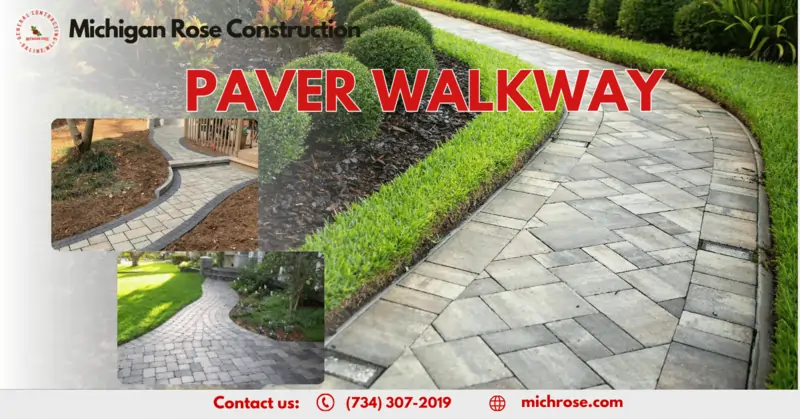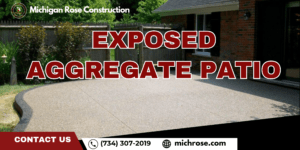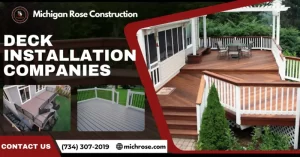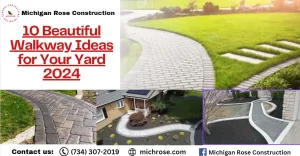Introduction
Does your Michigan home lack that certain curb appeal? Cracked concrete paths leaving an eyesore first impression? Here in the Mitten State, the freeze-thaw cycle can wreak havoc on traditional walkways. But fear not, homeowners! Paver walkways offer a stylish and durable solution built to withstand Michigan’s toughest weather conditions.
In this blog, we’ll delve into the many reasons why paver walkways are the perfect choice for your Michigan home. We’ll explore the benefits of pavers over traditional materials, the design possibilities they offer, and how they can add value and functionality to your property. So buckle up and get ready to transform your entryway from mundane to magnificent!
Paver Walkways
Paver walkways are paths made from individual pavers or blocks rather than poured concrete. Pavers are available in a variety of shapes, styles, colors, textures and materials to fit any landscape design.
Compared to poured concrete, paver walkways offer many benefits:
- More aesthetic options – Pavers come in endless colors, shapes, textures to match your home. Concrete is limited to a gray slab look.
- Easier to install – Pavers can be installed by DIYers over a gravel base. Concrete requires forms, proper slope and professional finishing.
- Longer lasting – Pavers won’t crack like concrete. Damaged pavers can be replaced individually.
- Better traction – The shape and texture of pavers prevent slipping and provide better traction than smooth concrete.
- Permeable options – Permeable pavers allow water to drain through gaps between them, reducing runoff.
The most popular paver materials are:
- Concrete – Affordable and durable but prone to efflorescence, a white hazy appearance over time.
- Clay brick – Classic look but more expensive and prone to cracking.
- Natural stone – Granite, bluestone, limestone, etc. Beautiful but very expensive. Requires more maintenance.
- Porcelain – Impervious to weather, stain-resistant and has realistic stone looks. But heavy and expensive.
- Interlocking concrete – Very durable and long-lasting. Available in many shapes and colors. The most budget-friendly option.
The shape and pattern possibilities are endless with pavers. The most common paver styles are square, rectangular, hexagonal, circular and tumbled.
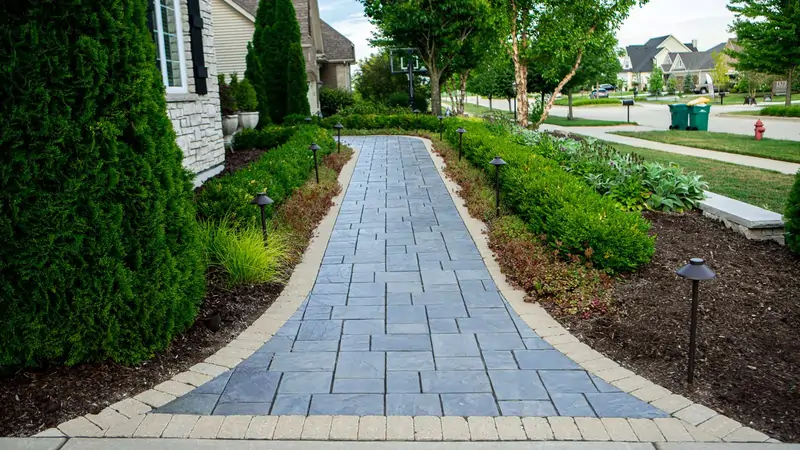
Planning Your Paver Walkway
Installing a paver walkway requires careful planning and preparation to ensure it lasts for years to come. Here are some key factors to consider:
Drainage and Slope
Proper drainage is critical for a long-lasting paver walkway. Water should drain away from the house and off the sides of the path. A slight slope of 1/8 to 1/4 inch per foot is ideal. Use a level and stakes to mark the slope. Avoid overly steep slopes which can lead to erosion.
Width
Consider the walkway’s purpose when planning the width. A main path to the front door should be 36-48 inches wide. Narrower 18-24 inch paths work well for garden walkways. Wider walkways allow two people to walk comfortably side-by-side.
Base Preparation
Proper base preparation is crucial. Excavate at least 6 inches deep and add a 4-inch gravel base. Compact the gravel and level it before installing 1-2 inches of sand. This provides drainage and a solid foundation for the pavers.
Careful planning for drainage, width, and base preparation makes for a long-lasting, functional paver walkway you’ll enjoy for years. Prepare the base properly before installing pavers.
Paver Walkway Patterns
Paver walkway patterns add visual interest and style to your outdoor space. Choosing the right pattern is an important design decision that impacts the overall look, cost, and installation complexity of your walkway. Here are some of the most popular paver patterns to consider:
Herringbone
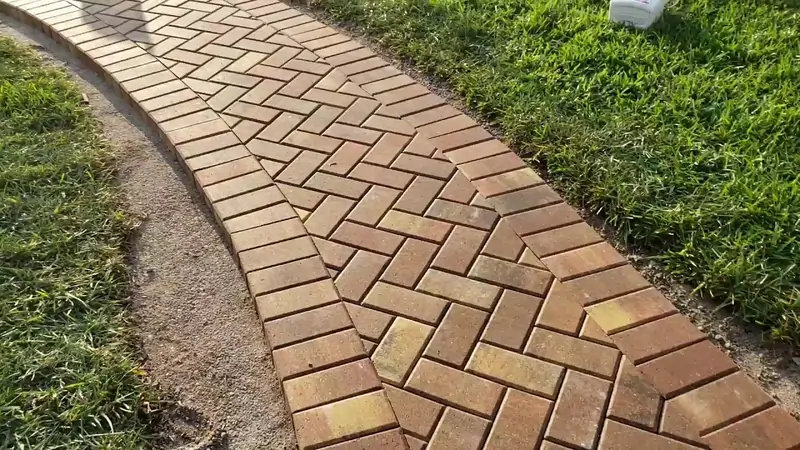
The herringbone pattern features rectangular pavers placed in an interlocking arrangement that resembles a herringbone pattern. Pavers are laid at 45 or 90 degree angles to each other in alternating rows.
Pros:
- Creates a classic, timeless look
- Naturally guides the eye down the walkway
- Hides imperfections in paver spacing
Cons:
- More complex installation
- Can be more expensive due to extra cutting and angle placement
Basketweave
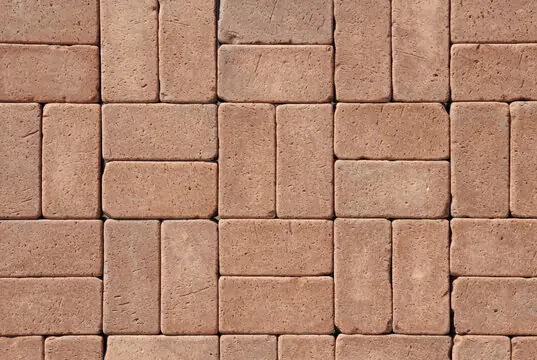
Basketweave patterns feature rectangular pavers woven in an over-under pattern resembling a basket weave fabric. Each paver is laid perpendicular to the adjacent pavers.
Pros:
- Interesting visual texture
- Conceals minor imperfections or unevenness
- Versatile for many design styles
Cons:
- Requires more precision in paver layout
- Individual pavers can get slightly out of alignment
Stacked Bond
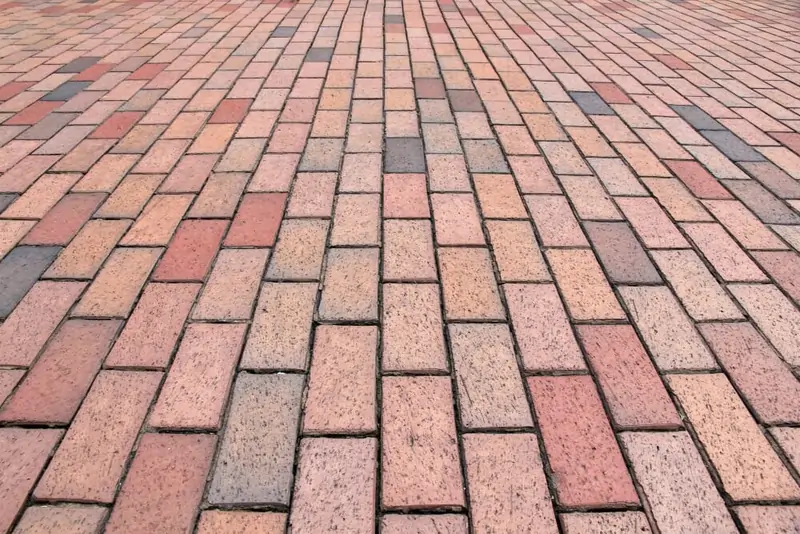
Stacked bond patterns feature pavers stacked in a grid or running bond pattern with continuous straight joints. Rectangular pavers are laid in straight rows off-set by half a paver length each row.
Pros:
- Clean, uniform appearance
- Easier installation than intricate patterns
- Cost-effective option
Cons:
- Can highlight any imperfections in paver spacing
- Less visually interesting than other patterns
The pattern you select can increase material and labor costs, especially for more intricate layouts like herringbone that require cutting pavers and precision installation. Simple patterns like stacked bond tend to be the most budget-friendly options. Consulting a professional installer can help weigh the pros and cons of each pattern for your specific project.
Paver Walkway Borders
When installing a paver walkway, an important consideration is choosing borders to contain the pavers. There are several options for paver borders, each with their own pros and cons.
Concrete Borders
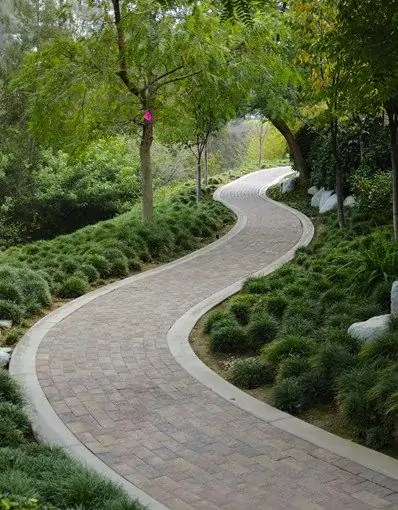
Concrete makes a durable and long-lasting border for paver walkways. Concrete borders are installed by digging a trench around the perimeter of the walkway, adding rebar for reinforcement, and pouring concrete into the trench.
Pros:
- Very strong and durable
- Won’t shift or move over time
- Provides a clean, smooth edge
Cons:
- More expensive than other options
- Installation requires more labor and equipment
Plastic Borders
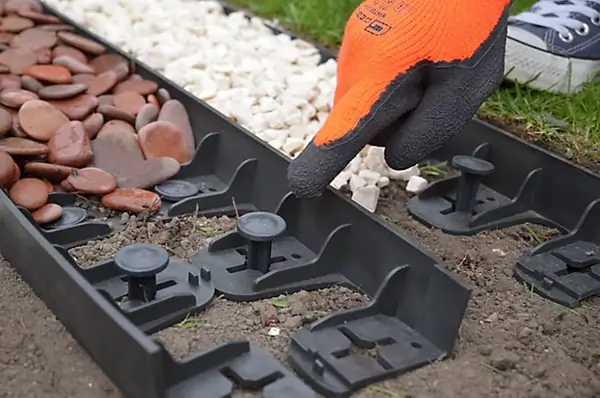
Plastic lawn edging comes in flexible strips that can be installed around the edges of a paver walkway. These plastic borders are easy to work with and bend to create curved borders.
Pros:
- Inexpensive
- Easy to install
- Come in various colors
Cons:
- Can become brittle and crack over time
- Provide less structure than concrete borders
Metal Borders
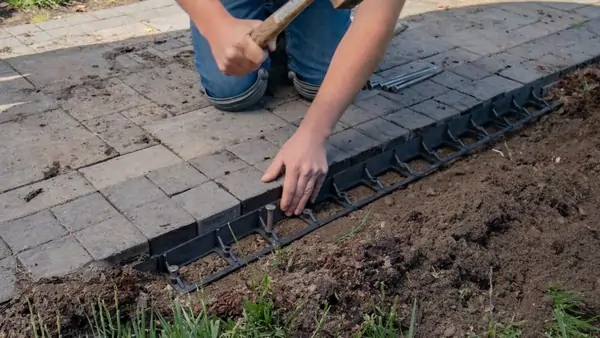
Metal strips like aluminum and galvanized steel can be installed around paver walkways to create a border. These metal lawn edging strips provide a clean finish.
Pros:
- Durable and long-lasting
- Easy to install
- Straight or curved options
Cons:
- Can be more expensive
- Lacks flexibility if adjustments need to be made
Stone Borders
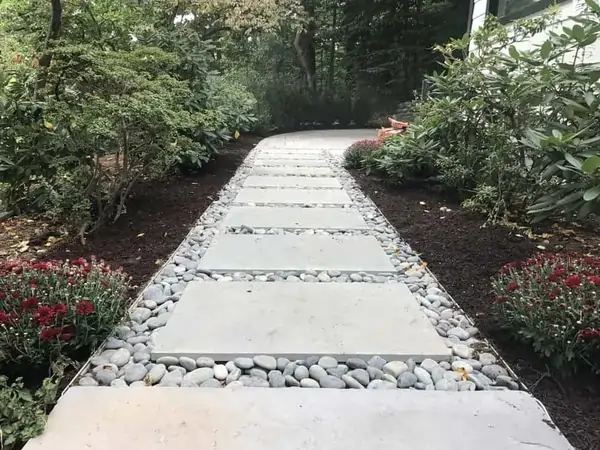
Using stone or brick to create borders is a classic choice for paver walkways. Stones like granite cobblestones or bricks are arranged around the edges.
Pros:
- Complements the look of pavers
- Natural appearance
Cons:
- Installation is more labor intensive
- Stones may settle or shift over time
For most paver walkways, concrete makes the best border option due to its strength, durability, and clean edges. Plastic or metal borders can also be good choices if looking for easier installation or a more affordable option. The border you choose will depend on your budget, design preferences, and how much labor you can provide for installation.
Choosing the Right Pavers
When it comes to choosing pavers for your walkway, you have several material options to consider including concrete, brick, and natural stone. Each paver material has its own unique properties, advantages, and disadvantages that are important to weigh when deciding what will work best for your project.
Concrete Pavers
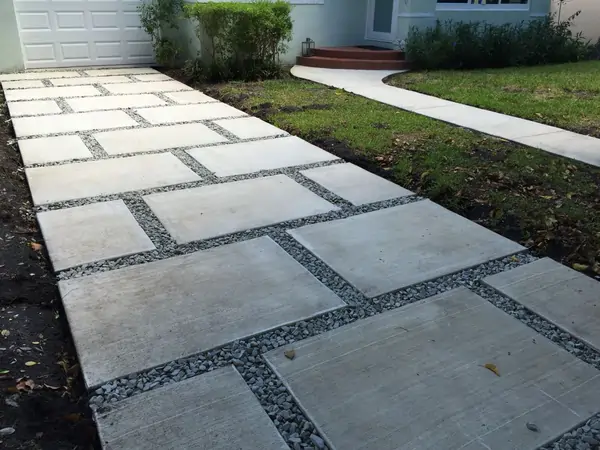
Concrete pavers are a popular choice for many homeowners due to their affordability and durability. Concrete pavers are man-made from a mixture of cement, aggregate, and other materials. The biggest advantage of concrete pavers is their low cost compared to other paver options. They can withstand heavy foot traffic without cracking or chipping. Concrete pavers also come in a diverse range of shapes, styles, colors, and textures to choose from.
On the downside, concrete pavers are more prone to staining from leaves, soil, and other organic materials. They may also fade over time from sunlight exposure. Additionally, concrete does not provide the same natural beauty as real stone or brick.
Brick Pavers
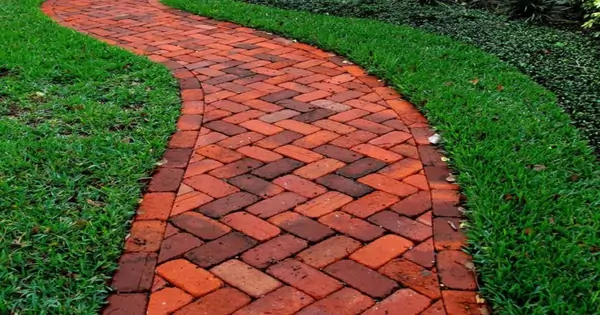
Brick pavers have a classic, timeless look that fits well with many home design styles. Bricks come in a variety of colors like red, brown, grey, and tan. They are very durable against cracking and chipping. Brick pavers can last 50 years or longer when properly installed and cared for.
The biggest downside to brick pavers is the higher material cost compared to concrete. They also require more extensive base preparation during installation. Sealing and resealing the bricks every few years is recommended to prevent fading and stains.
Natural Stone Pavers
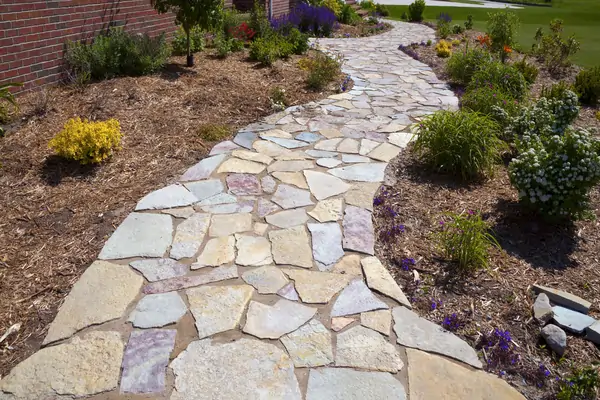
For a premium paver walkway, natural quarried stone is an excellent choice. Materials like bluestone, travertine, limestone, granite, and sandstone make beautiful, unique pavers. Natural stone offers an elegant, luxurious look that can significantly enhance your landscape’s curb appeal.
Stone pavers have a very long lifespan, often over 100 years. They are extremely durable and resilient against cracking or chipping. Stone won’t fade from sun exposure or stain easily. There are also many diverse stone colors, textures, shapes, and patterns to choose from.
The main drawback with natural stone pavers is the higher upfront cost. They also require more complex installation preparations. Natural stone weighs more than concrete or bricks, so the underlying base must be very stable.
When weighing the pros, cons, and costs of paver materials, it helps to have a budget in mind. Concrete pavers offer an affordable option starting at $2-$6 per square foot. Brick pavers cost $6-15 per square foot on average. For a premium paver walkway, natural stone averages $15-$30 per square foot.
Paver Installation Process
Installing pavers is a rewarding DIY project that can greatly enhance the look and functionality of your outdoor living space. With some preparation and the right tools, you can have a beautiful new paver walkway, patio or driveway. Here is a step-by-step guide to paver installation:
Tools and Materials
- Shovel
- Rake
- Wheelbarrow
- Landscape fabric
- Crushed stone
- Sand
- Plate compactor
- Rubber mallet
- Spacers
- Pavers
- Polymeric sand
Step-by-Step Installation
- Excavate the Area – Dig out and level the area, allowing for a 4-6 inch base. Slope the base away from structures for drainage.
- Install Landscape Fabric – Line the excavated area with landscape fabric to block weeds. Overlap seams at least 6 inches.
- Add Gravel Base – Spread 4 inches of crushed stone over the area. Compact it down with a plate compactor.
- Install Edge Restraints – Place edge restraints around the perimeter to hold the pavers in place. Use landscape edging, plastic edging, or concrete.
- Add Sand Base – Spread 1-1.5 inches of sand over the compacted gravel base. Smooth it with a rake.
- Set the Pavers – Lay the pavers in your chosen pattern. Use spacers to leave 1/8 inch gaps between pavers. Tap into place with a rubber mallet.
- Compact the Pavers – Use a plate compactor to compress the pavers into the sand. Vibrating the pavers locks them together.
- Fill Gaps with Sand – Sweep polymeric sand over the surface, filling the joints completely. Sweep off excess sand.
- Compact Again – Make a final pass with the plate compactor to settle the sand into the joints. This stabilizes the pavers.
- Seal the Surface – Once compacted, spray the entire surface with polymeric sand sealer. This prevents erosion between the joints.
Tips
- Allow a 1-2 inch overage around the perimeter for cutting border pavers to fit.
- Cut pavers with a chisel and hammer or a brick splitter.
- Work in sections of about 10-15 square feet at a time to keep the pavers manageable.
- Tamp pavers frequently to prevent shifting.
- Check for level and slope as you go using a screed board and level.
Following these paver installation steps and using the right materials will result in a durable, great-looking paver walkway or patio. Be sure to maintain it properly to keep your pavers looking their best for years to come.
Caring for Your Paver Walkway
Properly caring for your paver walkway will help it last for decades. Here are some tips:
Cleaning
- Use a stiff broom to sweep away dirt, leaves, and other debris. This prevents accumulation that can stain pavers.
- For a deeper clean, use a pressure washer on a low setting. Avoid abrasive cleaners that can damage the pavers.
- To remove stubborn stains like oil, mix dish soap and warm water and scrub with a stiff brush. Rinse thoroughly.
- Avoid weed killer sprays that can seep between pavers and damage plants nearby. Hand pull weeds instead.
Re-Sanding
- Over time, sand between pavers can erode away from weather and foot traffic.
- Add fresh polymeric sand every 1-2 years to fill gaps and lock pavers firmly in place. Sweep thoroughly before re-sanding.
Sealers
- Pavers are porous, so sealers prevent stains from absorbing into the surface. They also provide protection from weather damage.
- Use solvent-based acrylic sealers for the best durability. Reapply every 2-3 years.
- Avoid film-forming sealers which peel and flake over time. Always read the manufacturer’s directions.
With proper maintenance like regular cleaning, re-sanding, and sealing, you can keep your paver walkway looking brand new for decades. Contact a professional paver installation company if you need help caring for your walkway.
Cost of Paver Walkway Installation
Installing a paver walkway can significantly enhance the look and functionality of your outdoor space. However, it’s important to understand the costs involved before starting a paver project. Here’s an overview of what to expect in terms of paver walkway installation costs.
The average cost to install a paver walkway is $10-$15 per square foot. However, many factors influence the total project cost.
Materials
The type of pavers chosen is one of the biggest factors affecting cost. Here are some typical price ranges for paver materials:
- Concrete pavers – $2-$5 per square foot
- Brick pavers – $5-$15 per square foot
- Natural stone pavers – $15-$30+ per square foot
More expensive paver materials like natural flagstone, travertine, bluestone, and granite can raise costs significantly, while basic concrete pavers offer cost savings.
The subbase materials like gravel, sand, and base materials can add $2-$5 per square foot. Edging materials, decorative accents, and lighting will also impact the bottom line.
Complexity
Simple straight paver paths that are relatively flat and easy to access tend to cost less than intricate designs, steep terrain, steps, curves, and raised patio installations. Complex patterns, custom shapes, and specialty cuts will require more labor and expertise, increasing project costs.
Site Preparation
If the walkway installation area needs excavation, grading, drainage improvements, or tree/shrub removal, costs add up quickly. Similarly, if the soil base is unstable and needs soil stabilization, expect added expenses.
Labor
Professional paver installation requires skilled labor. Simple DIY projects may cost $5-$8 per square foot, while hiring a landscape contractor often averages $10-$25 per square foot for quality workmanship. Many paver suppliers offer installation services which provide convenience but often have higher prices.
Location
Where you live can significantly impact labor and material prices. Paver installation costs in a major metro area are often higher than in surrounding suburbs or rural areas due to cost of living factors.
With so many variables, it’s important to get an itemized quote from paver installation professionals before starting your project. They can assess your site conditions and materials to provide an accurate estimate.
Paver Walkway Ideas
Paver walkways allow for immense creativity and customization. With the wide variety of paver shapes, colors, textures, and patterns available, you can design a unique walkway that reflects your style. Consider these ideas to make your paver walkway stand out:
Mix Pavers Shapes and Sizes

Using different sized pavers together can create visual interest. Try combining large square pavers with smaller rectangular ones in pleasing geometric patterns. Or alternate between large and small pavers randomly for a more eclectic look. Mixing paver shapes like squares, rectangles, and hexagons also adds appealing variation.
Form Creative Patterns
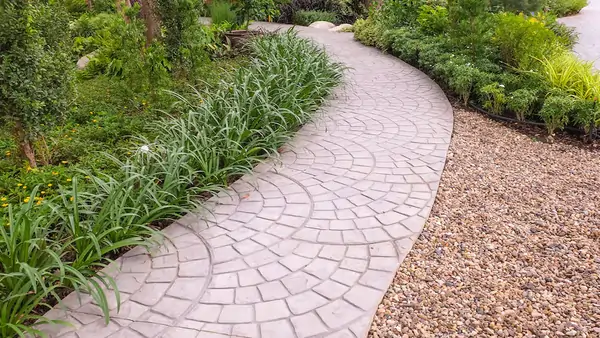
Basketweave, herringbone, running bond, and other arrangements create stunning patterns with pavers. Contrasting colors between pavers make the designs pop even more. For a personalized touch, incorporate initials, names, or custom shapes into the paver layout.
Add Borders and Banding
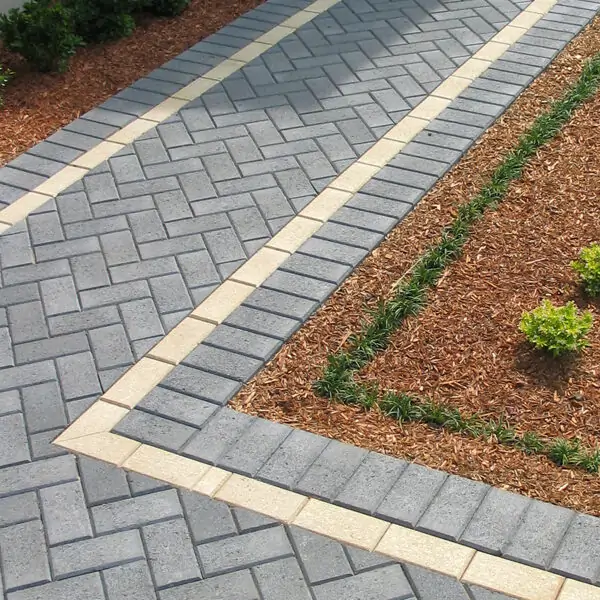
Define the edges of your walkway with borders and banding. Lay pavers on a 45-degree angle along the sides, or border it with bricks or cut stone. For banding, a paver border that cuts across the middle of the walkway adds neat definition.
Use Multiple Colors
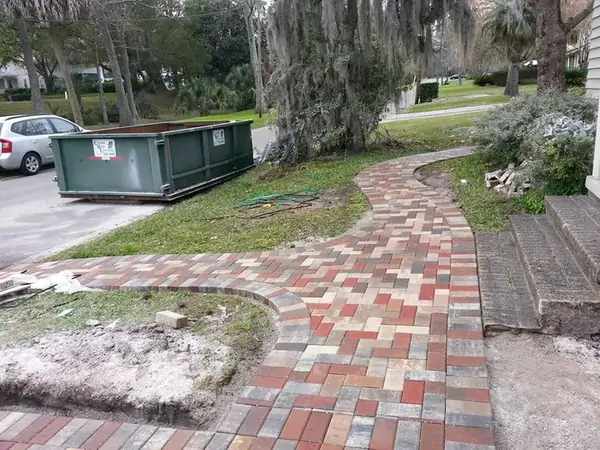
Varying paver hues prevents a monotonous look. But stick to a color scheme, like complementary or analogous colors, for cohesion. Neutrals like tans, browns, and grays make a versatile base for bolder accent colors. Limit highly saturated hues to prevent an overly busy appearance.
Include Accent Features
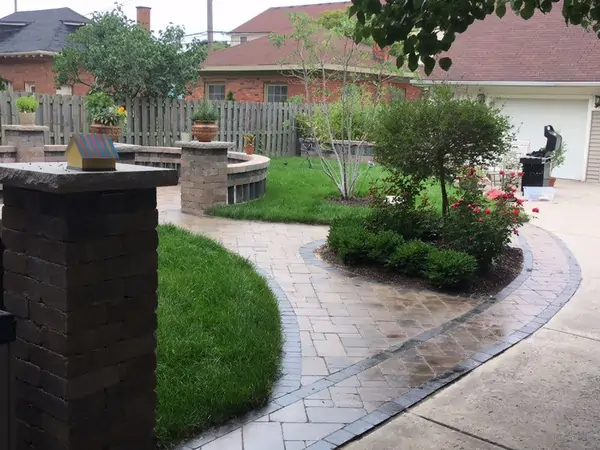
Lighting, planters, benches, pergolas, and other features elevate a paver walkway. Solar lights along the edges add ambiance and visibility at night. Planters with flowers, bushes, or small trees provide color and softness. Benches create a place to relax and enjoy the space.
Add Stepping Stones
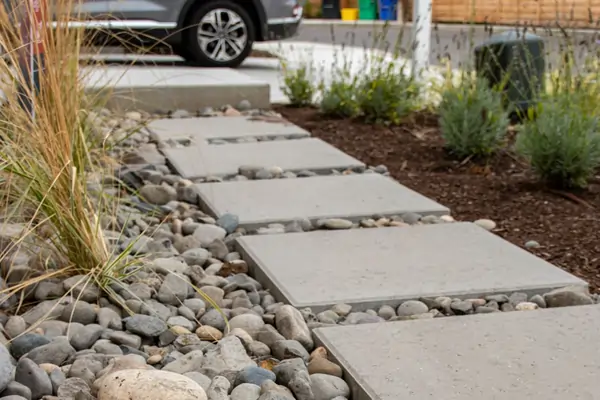
Stepping stone pathways made of natural stone or pavers winding through gardens make an appealing accent. They can connect to the main walkway or stand alone. Leave small planting spaces between the stones for greenery.
With smart design choices, you can create a one-of-a-kind paver walkway tailored to your home’s style and your unique taste. Get creative with patterns, textures, colors and accent features for a personalized look.
Hiring a Michigan Paver Installation Company
Installing a paver walkway can be a big project, so you may want to consider hiring a professional company to handle it. Here are some tips on finding and selecting a quality paver installation company in Michigan:
Benefits of Hiring a Professional
- Experience and expertise: A professional paver company has done many walkway installations and knows how to properly prep the base, lay pavers, sand and seal for best results.
- Correct tools and equipment: Professional pavers have the right tools, like plate compactors and paver saws, to efficiently install the walkway correctly.
- Knowledge of building codes: A paver company will ensure the walkway meets local regulations, like having a proper base depth.
- Warranty: Many professional pavers provide a warranty on their installation workmanship.
- Time savings: A professional team can complete the paver walkway much faster than a DIY homeowner.
Questions to Ask Potential Companies
- How long have you been in business installing pavers? Look for an established company with at least 5-10 years experience.
- Are you licensed and insured? Make sure they carry liability insurance and required licenses.
- Can I see examples of your work? Ask to see photos of recently completed paver projects.
- What is your process? A quality company will describe their process from site prep to final sealing.
- Do you provide a warranty? Get warranty details on their workmanship. Many offer 1-5 year warranties.
- Can you provide references from past clients? Speaking with references can give you insights on their quality.
Characteristics of a Quality Company
- Membership in trade organizations like the Interlocking Concrete Pavement Institute.
- Glowing online reviews praising their craftsmanship and service.
- A portfolio showing beautiful, well-constructed paver projects.
- A detailed process explaining how they properly prepare and install pavers.
- Established for 10+ years demonstrating stability and experience.
- Offers a multi-year workmanship warranty on their paver installations.
For professional paver walkway installation in Michigan, contact Michigan Rose Construction today! Their team of seasoned experts will partner with you to create your ideal paver walkway.
For more details, visit Michigan Rose Construction Facebook Page or you can call (734) 307-2019

